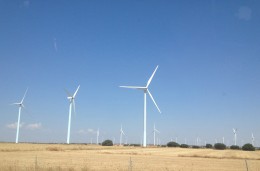On Saving Money with Solar Panels, Renewable Energy, and Such Like

Driving through the deserts of La Mancha, Spain, the summer of 2013, I saw windmills everywhere. Considering the Don Quixote connection, that seemed appropriate, except these weren’t the old-fashioned kind; these were sleek, regal, tireless turbines. They were making use of otherwise somewhat desolate space. Great, right? (Yes.) But why, I wondered, weren’t there likewise solar panels everywhere?
My little family was in Spain for three weeks as part of our Great Escape and I don’t recall seeing the rain once. It was nothing but blue skies from now on in Espana, and yet people didn’t seem to be capitalizing on the enormous powers of the sun.
Maybe solar was too cumbersome. Maybe the start up costs were too high. But at least one person has found workarounds and has been surprisingly satisfied by the results:
I noticed that many houses in Washington had yard signs saying that they had switched to solar power. It seemed like an attractive option from a sustainability perspective, but would it make sense financially? I had heard for years that solar power was a luxury item for hippies and rich liberals. But after doing some research, I learned that the price of solar panels had decreased 80 percent since 2008. Even more surprising, I discovered that I didn’t have to spend a huge sum of money upfront to buy solar panels anymore — instead, I could lease them.
How does that work exactly?
When I began my solar-power journey, the first question I faced was: Should I buy, or should I lease? The way solar leasing works is that a company installs panels on your roof. Rather than paying for the panels themselves, you are charged for the electricity they generate. (The exact way this works depends on the agreement you sign. In some cases, you’re charged for all the electricity the system generates, and the extra that goes into the grid generates a credit from the local utility company to lower your bill. In other cases, you are charged a fixed fee from the solar company regardless of how much energy your panels produce.) In many cities across the United States, the solar electricity rate is actually lower than what you’d pay on your regular utility bills. So I could save money and reduce pollution by leasing solar panels? It sounded like a no-brainer.
The author now has plenty of fun factoids to share, about the experience and about the results. For example, “One kilowatt-hour can power a ceiling fan for 12 hours, make 36 pieces of toast, or blend 400 frozen margaritas. On the other hand, 1 kilowatt-hour can give you 12 minutes of central air conditioning. Maybe we should be making more margaritas and less cold air.”
If you can’t invest in solar panels or the like, though, there’s always planting trees! “Between now and 2050, trees and charcoal are the “most promising” technologies out there, it said.” Relatively cheap, relatively easy. NOTE: This is not a cure-all for global warming. But then, what is?
Have you ventured into the renewable energy, “save money and reduce pollution” game? Have any fun stories to share of either victory or defeat? Have you found green energy worth it?
Support The Billfold
The Billfold continues to exist thanks to support from our readers. Help us continue to do our work by making a monthly pledge on Patreon or a one-time-only contribution through PayPal.
Comments